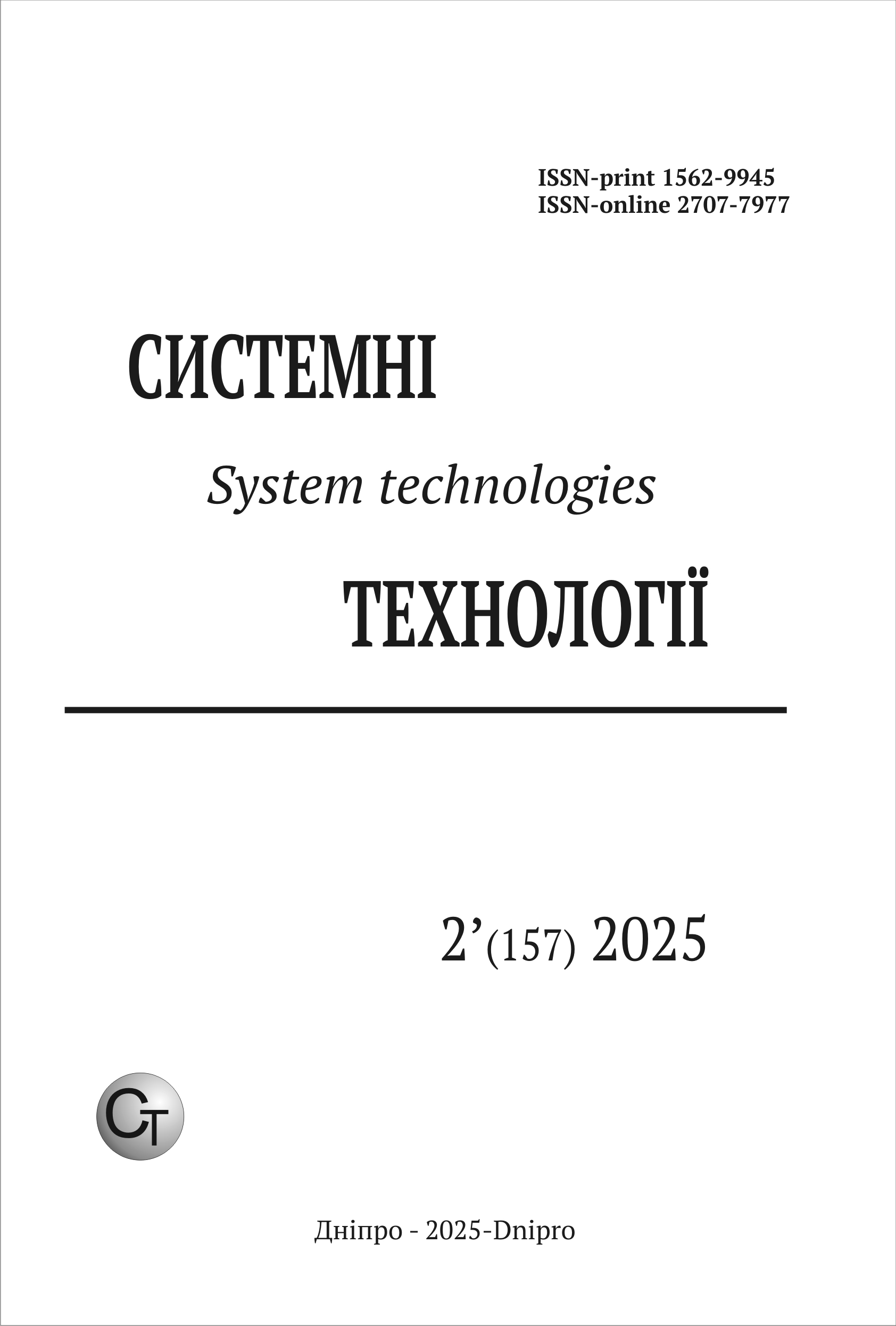Обробка відео з дронів шляхом фрагментного аналізу
DOI:
https://doi.org/10.34185/1562-9945-2-157-2025-01Ключові слова:
Фрагментація відеопотоку; Норма Кі-Фана; Розкладання сингулярного значення; Дрони, виявлення об'єктів; Рухома камера; Аналіз даних, обробка відеоАнотація
В цьому дослідженні ми зосередилися на аналізі відео з дронів для вирішення за-дачі обробки фрагментів відео, знятих рухомою камерою. Кожен кадр розділений на менші фрагменти за допомогою методу сегментації на основі сітки, що дає змогу ло-калізувати та детально аналізувати рух. Сингулярне розкладання (SVD) застосо-вується для обчислення норми Кі Фан для кожного фрагменту, що дозволяє виявити динамічні зміни між послідовними кадрами. Аналіз на рівні фрагментів дозволяє алго-ритму надійно визначати області інтересу та розрізняти глобальний рух (рух камери) і локальний рух (рух об’єкта), незважаючи на проблеми, пов’язані з нестабільністю камери. Стан руху класифікується на чотири категорії: стабільна камера без руху об’єкта, стабільна камера з рухом об’єкта, рухома камера без руху об’єкта та рухома камера з рухом об’єкта. Ця методологія на основі фрагментів підвищує точність ди-намічного аналізу сцени, пропонуючи масштабоване та ефективне рішення для таких підходів, як стабілізація відео, відстеження об’єктів і виявлення руху в реальному часі в складних середовищах.
Посилання
Madhavan, R., Silva, T., Farina, F., Wiebbelling, R., Renner, L., & Prestes, E. (2018). Un-manned aerial vehicles for environmental monitoring, ecological conservation, and disaster management. In Technologies for Development: From Innovation to Social Impact (pp. 31-39). Springer International Publishing. DOI: 10.1007/978-3-319-91068-0_3
Mohsan, S. A. H., Othman, N. Q. H., Li, Y., Alsharif, M. H., & Khan, M. A. (2023). Un-manned aerial vehicles (UAVs): Practical aspects, applications, open challenges, security is-sues, and future trends. Intelligent Service Robotics, 16(1), 109-137. DOI: 10.1007/s11370-022-00452-4
Akbari, Y., Almaadeed, N., Al-Maadeed, S., & Elharrouss, O. (2021). Applications, data-bases and open computer vision research from drone videos and images: a survey. Artificial Intelligence Review, 54, 3887-3938. DOI: 10.1007/s10462-020-09943-1
Arafat, M.Y., Alam, M.M., & Moh, S. (2023). Vision-based navigation techniques for un-manned aerial vehicles: Review and challenges. Drones, 7(2), 89. DOI: 10.3390/drones7020089
Heakl, A., Youssef, F., Parque, V., & Gomaa, W. (2024). DroneVis: Versatile Computer Vision Library for Drones. arXiv preprint arXiv:2406.00447. DOI: 10.48550/arXiv.2406.00447
Rohan, A., Rabah, M., & Kim, S. H. (2019). Convolutional neural network-based real-time object detection and tracking for parrot AR drone 2. IEEE access, 7, 69575-69584. doi: 10.1109/ACCESS.2019.2919332
Han, S., Shen, W., & Liu, Z. (2016). Deep drone: Object detection and tracking for smart drones on embedded system. URL https://web. stanford. edu/class/cs231a/prev_projects_2016/deepdrone-object__2_. pdf.
Yazdi, M., & Bouwmans, T. (2018). New trends on moving object detection in video im-ages captured by a moving camera: A survey. Computer science review, 28, 157-177. DOI: 10.1016/j.cosrev.2018.03.001
Yang, J., Xie, X., & Wang, Y. (2017, April). Design of video surveillance and tracking sys-tem based on attitude and heading reference system and PTZ camera. In 2017 5th Interna-tional Conference on Computer-Aided Design, Manufacturing, Modeling and Simulation (CDMMS 2017) (Vol. 1834, No. 1, p. 040016). DOI: 10.1063/1.4981612
Chen, P., Dang, Y., Liang, R., Zhu, W., & He, X. (2017). Real-time object tracking on a drone with multi-inertial sensing data. IEEE Transactions on Intelligent Transportation Sys-tems, 19(1), 131-139. doi: 10.1109/TITS.2017.2750091
Dames, P., Tokekar, P., & Kumar, V. (2017). Detecting, localizing, and tracking an un-known number of moving targets using a team of mobile robots. The International Journal of Robotics Research, 36(13-14), 1540-1553. DOI: 10.1177/0278364917709507
Leal-Taixé, L., Milan, A., Schindler, K., Cremers, D., Reid, I., & Roth, S. (2017). Track-ing the trackers: an analysis of the state of the art in multiple object tracking. arXiv preprint arXiv:1704.02781. DOI: 10.48550/arXiv.1704.02781
Risse, B., Mangan, M., Del Pero, L., & Webb, B. (2017). Visual tracking of small animals in cluttered natural environments using a freely moving camera. In Proceedings of the IEEE international conference on computer vision workshops (pp. 2840-2849). https://openaccess.thecvf.com/content_ICCV_2017_workshops/papers/w41/Risse_Visual_Tracking_of_ICCV_2017_paper.pdf
Bouwmans, T. (2014). Traditional and recent approaches in background modeling for foreground detection: An overview. Computer science review, 11, 31-66. DOI: 10.1016/j.cosrev.2014.04.001
Yilmaz, A., Javed, O., & Shah, M. (2006). Object tracking: A survey. Acm computing surveys (CSUR), 38(4), 13-es. DOI: 10.1145/1177352.1177355
Wren, C. R., Azarbayejani, A., Darrell, T., & Pentland, A. P. (1997). Pfinder: Real-time tracking of the human body. IEEE Transactions on pattern analysis and machine intelli-gence, 19(7), 780-785. doi: 10.1109/34.598236
Zhai, W., Xiong, X., Mo, G., Xiao, Y., Wu, C., Xu, Z., & Pan, J. (2024). A Bagging-SVM field-road trajectory classification model based on feature enhancement. Computers and Elec-tronics in Agriculture, 217, 108635. DOI: 10.1016/j.compag.2024.108635
Zhai, W., Xu, Z., Pan, J., Guo, Z., & Wu, C. (2024). A general image classification model for agricultural machinery trajectory mode recognition. Computers and Electronics in Agri-culture, 227, 109629. DOI: 10.1016/j.compag.2024.109629
Bouwmans, T., Sobral, A., Javed, S., Jung, S. K., & Zahzah, E. H. (2017). Decomposition into low-rank plus additive matrices for background/foreground separation: A review for a comparative evaluation with a large-scale dataset. Computer Science Review, 23, 1-71. DOI: 10.1016/j.cosrev.2016.11.001
T. Bouwmans, T., Aybat, N. S., & Zahzah, E. H. (Eds.). (2016). Handbook of robust low-rank and sparse matrix decomposition: Applications in image and video processing. CRC Press. https://dl.acm.org/doi/abs/10.5555/2994445
Ebadi, S. E., Ones, V. G., & Izquierdo, E. (2015, September). Efficient background sub-traction with low-rank and sparse matrix decomposition. In 2015 IEEE International Confer-ence on Image Processing (ICIP) (pp. 4863-4867). IEEE. doi: 10.1109/ICIP.2015.7351731.
Wu, Y., He, X., & Nguyen, T. Q. (2015). Moving object detection with a freely moving camera via background motion subtraction. IEEE Transactions on Circuits and Systems for Video Technology, 27(2), 236-248. doi: 10.1109/TCSVT.2015.2493499
Tomasi, C. (2012). Histograms of oriented gradients. Computer Vision Sampler, 1-6.
Koliada, M. “Ky fan norm application for video segmentation”. Herald of Advanced In-formation Technology, 2020;1(3), 345-351. DOI: 10.15276/hait.01.2020.1
Mashtalir, S., & Lendel, D. “Video pre-motion detection by fragment processing”. CEUR Workshop ProceedingsVolume. 2024; 3790, pp. 342 – 351. https://www.scopus.com/inward/record.uri?eid=2-s2.0-85207837522&partnerID=40&md5=26529ee16efb141face273bd943660d5
Mashtalir, S. V. & Lendel D. P. “Video fragment processing by Ky Fan norm”, Appl. Asp. Inf. Technol. 2024; 7.1: 59 68. DOI: DOI: 10.15276/aait.07.2024.5
Sergii V. Mashtalir, Dmytro P. Lendel (2024). Moving object shape detection by fragment processing. Herald of Advanced Information Technology. 7(4), 414-423. DOI: 10.15276/hait.07.2024.30
Завантаження
Опубліковано
Номер
Розділ
Ліцензія
Авторське право (c) 2025 Системні технології

Ця робота ліцензується відповідно до ліцензії Creative Commons Attribution 4.0 International License.















